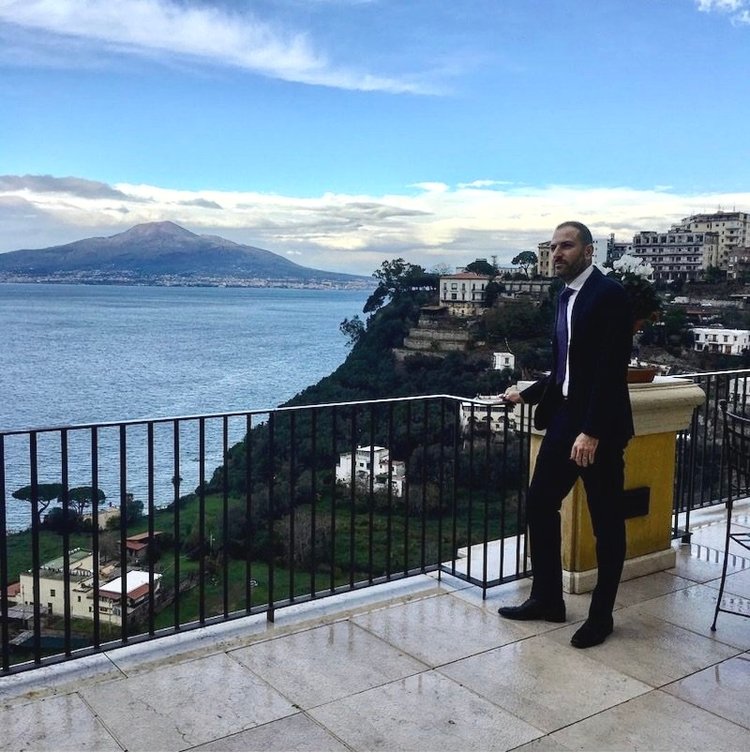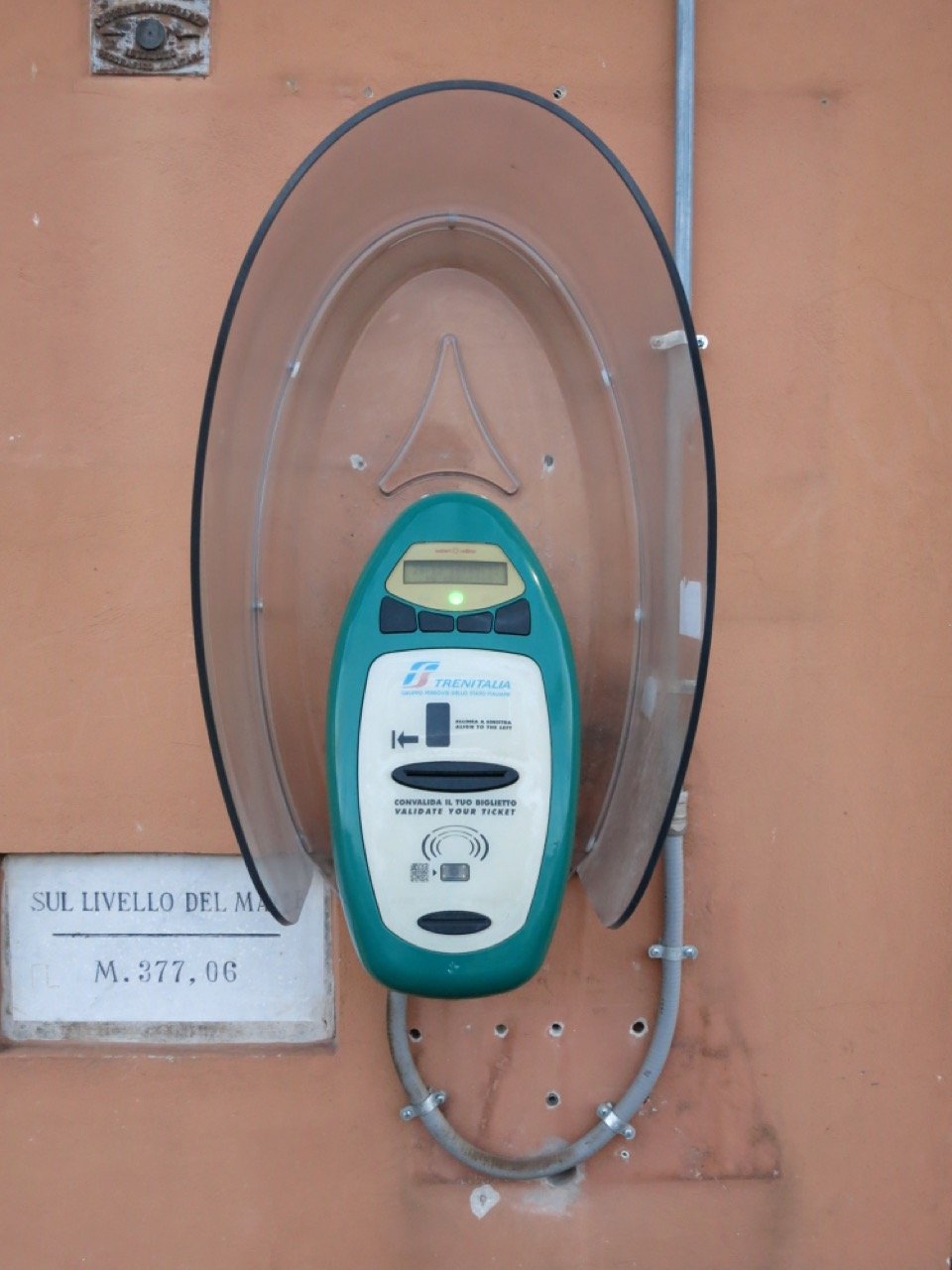Taking the Train from Rome to Naples
If you’re planning a trip to Italy and wondering how to get from Rome to Naples by train, we’ve broken it all down for you here.
Most travelers’ first stop on their Italy travels is Rome. And rightly so! Every trip to Italy should make time for at least a couple days of exploring the nation’s capital and most storied city.
But sadly, your time in the cittá eterna must come to an end at some point. And when it does, you’ll need to know how to get to your next destination. If you’re thinking about Naples and the Amalfi Coast for your next stop, read on for all you need to know on how to make the journey from Rome to Naples.
From Rome, the quickest and easiest way to get to Naples is to take a high-speed train. Trenitalia’s Frecciarossa trains depart multiple times per hour from Rome’s Termini train station and drop you in Naples’ city center at Napoli Centrale station. Departures begin as as early as 7:00 am and run until around 11:00 pm. The journey takes just over one hour and tickets cost as little as 15 euros if purchased in advance. Italotreno, a private train company, also runs 2 trips per hour with the same 1-hour travel time.
It’s as easy as that - in just an hour from Rome, and with minimal fuss, you’ll find yourself stepping out into Naples’ glorious chaos.
Table of Contents
See more of our Italy travel guides:
Amalfi Coast planning cheatsheet
 Plan your itinerary with expert advice
Plan your itinerary with expert advice
- Book an Italy travel consultation with a local expert
 My favorite hotels on the Amalfi Coast
My favorite hotels on the Amalfi Coast
- Maison La Minervetta - clifftop luxury overlooking Sorrento. $450/night
- Palazzo Marziale - gorgeous rooms in a restored palace in Sorrento. $200/night
- Casa Santangelo Suites - opulent style in the heart of Salerno. $250/night
- B&B il Duca d'Amalfi - excellent value in Salerno's old town. $110/night
 Guided tours and activities
Guided tours and activities
 How to get around
How to get around
- Car rentals with DiscoverCars
- Train tickets from Trenitalia and Circumvesuviana
- Bus routes at SITA
Rome to Naples by Train
Roma Termini Station to Napoli Centrale Station
1 hour travel time
10-30 euro total cost
Book online at Trenitalia or Italo.
Naples is located 223 kms (140 miles) south of Rome, and taking the train is the easiest and most comfortable way to get there. Two different train operators run this route: Trenitalia (the national rail service) and Italo (a private company). Both companies use the same tracks and the same train stations.
There are dozens of daily train departures from Rome’s Roma Termini and Tiburtina stations to Naples’ Napoli Centrale station. Departures start as early as 6 or 7 am and run until almost 11 pm. Trains leave every 15-20 minutes and the total journey time takes from 1-3 hours depending on the class of train that you book.
Trenitalia’s high-speed Frecciarossa trains run the journey in 1 hour and 10 minutes (and the same for Italo, which only runs high-speed trains). Tickets for the high-speed trains cost from 15 euros and up, depending on when you purchase. High-speed trains depart from Roma Termini station.
Slower Regionale trains cost less, but the journey takes 3 hours or more. They often depart from Tiburtina station. Tickets cost as little as 10 euros.
Rome’s train stations
Rome has two major train stations: Roma Termini and Roma Tiburtina. There is also a station called Roma Ostiense, but it is little used. Termini and Tiburtina both have metro stations that let you out directly into the train terminals.
Termini is the largest station of the bunch and also the most centrally located. It is almost always the most convenient point of departure or arrival for tourists. If you arrive to Rome’s Fiumicino airport and take the “Leonardo Express” train into the city, for example, you’ll be arriving to Roma Termini.
Roma Termini
Termini station is just a few minutes walk from Rome’s city center and can be reached with both the A and B Metro lines, a host of buses, and a relatively inexpensive taxi fare. Termini recently underwent an extensive renovation and is now quite pleasant. You’ll find lots of restaurants, a market, ATMs, and a shopping gallery inside, as well as plenty of English-speaking staff. None of this can be said for Tiburtina.
Roma Tiburtina
Tiburtina station is located 3 km (2 miles) northeast of Termini station, and 4 stops away on the Metro. It lies on the Metro B line and can also be reached by bus and taxi, but it will take a little longer than Termini, especially with traffic.
Trenitalia vs. Italo
When checking and booking train tickets in Italy, you have two companies and two websites to choose between: Trenitalia - www.trenitalia.com/ - and ItaloTreno (Italo) - www.italotreno.it/en.
Trenitalia is Italy’s national train service and is owned and operated by the State. It runs the vast majority of all train routes in Italy. Italo is a relative newcomer which exclusively operates high-speed trains on a number of Italy’s most heavily transited routes.
While all of Italo’s trains are high-speed, Trenitalia has all different classes of trains, with very slow Regionale trains, somewhat faster InterCity trains, high-speed Freccia trains, and on and on. Their high-speed trains are categorized as “Freccia” and there are yet three more levels of speed within that category: Bianco, Argento, and Rossa, with Rossa (Frecciarossa) being the fastest.
You have free WiFi available on all Italo trains, but only on Freccia trains for Trenitalia.
Where to buy train tickets
Your best bet is to purchase your tickets online on either company’s official website: https://www.trenitalia.com/ and https://www.italotreno.it/en.
You can also purchase tickets directly at the station or on the electronic ticketing machines located just before the tracks.
When to purchase your tickets
It’s always best to book your train tickets as far in advance as possible. For longer distance journeys in Italy, ticket prices increase the closer you get to your travel dates.
Intercity and Freccia trains increase in cost significantly as travel dates approach and last minute bookings could cost up to 4X more than advance bookings. Regionale trains, however, rarely vary in price, and seldom sell out, so there’s really no need to purchase them in advance.
Keep in mind that with Trenitalia tickets only become available 90-120 days before the date of travel. Therefore, you cannot purchase tickets more than 3-4 months in advance.
If you’re in a pinch and aren’t able to buy tickets in advance, you can also buy them aboard any train. There is a 5 euro surcharge for doing so, however. Also note that if buying a ticket aboard the train, you need to find the train conductor before they come to check your tickets. If you don’t and they arrive to find you without tickets, you can be fined.




Departure frequency and pricing
Trenitalia has 4-6 departures from Rome to Naples every hour, with most of them departing from Termini station. You will find a mix of slow and high-speed trains.
ItaloTreno has 2 departures each hour, all of them high speed.
Both train companies have departures as early as 5:00 am and as late as 10:30 pm. Choosing and purchasing your tickets is pretty easy, but there are some things you need to be aware of.
For high-speed trains you can generally expect to pay around 25-30 euros (each way) if you purchase at least one month in advance.
The above image shows us a number of the typical train options from Rome to Naples offered by Trenitalia. Proceeding from left to right, you have the departure time, the trip duration, the arrival time to Naples, the number of train changes, and then finally price. The specific class of train is listed directly above the time of departure and the train station of departure is listed directly beneath it. The arrival station is listed beneath the arrival time.
At the top of the image you have a Frecciarossa high-speed train which departs from Roma Termini station and completes the trip in 1 hour and 13 minutes. Beneath it, in the second position, you can see an Intercity train, with departure from Roma Tiburtina station, which takes 2 hours to make the journey. Beneath that, in the third position, you have a Regionale slow train (marked simply as “R”) which takes almost 3.5 hours to run the same route.
All three trains arrive to Napoli Centrale station. The Regionale train also has “1 change” which means that you will need to change trains somewhere during your route. The other options simply say “Details” which lets you know that they are direct trains.
You can see that there is little difference in price between the tickets when purchased in advance; the cheapest ticket, the Intercity, is just 5 euro cheaper than the high-speed Frecciarossa.
Train classes and luggage storage
Regular Trenitalia trains have two class levels: 1st and 2nd. However, Frecciarossa high-speed trains actually have 4 different classes, so we’ll cover those after first going over 1st and 2nd on all other trains.
Difference between 1st and 2nd class on Trenitalia
First things first, if there’s a big difference in price between first and second class, we never think that the upgrade is worth it. If the price difference is negligible, you might consider it though.
Both classes have seating in units of 4 seats with a 2 x 2 seat arrangement with rows of seats facing each other and a table in the middle. You have power outlets and overhead racks for luggage. There is almost always one bathroom per car.
On regular Trenitalia trains the major difference between the two classes is that 2nd class seats are cloth while 1st class are leather. The seats in 1st sometimes might be a bit bigger and the aisles a bit wider, but not necessarily. You will usually have more space for luggage in 1st and 1st class tickets usually entitles you to a free beverage or snack of some kind.
Frecciarossa train classes
If you didn’t have enough to think about already, with Frecciarossa trains you have 4 cabin classes: Standard, Premium, Business, Executive. All classes have free wifi, power sockets, overhead storage, and more storage at the beginning of the train. Eac Once we get to business and executive the seating layout changes.
Standard is just like 2nd class with the same layout and design.
Premium is identical to standard except for leather seats replace cloth and you get a complimentary drink included.
Business class becomes a bit more roomy. Seats are arranged 2 + 1 on one side of the aisle and 1 + 1 on the other, which is nice for couples. Each seating unit has a table. The leather seats are also larger than those in Standard or Premium, but do note that the leg room is the same. For those traveling in groups of 4, you can reserve a “salottino” which is a closed room with 4 seats. Business class also usually has a car that is reserved for silent seating, labeled as “business silenzio”.
Executive is the real deal if you’re up for a splurge. There are far fewer seats than in other classes (1 seat on each side and they do not face each other), the roomy leather seats recline, you have an included snack or meal, and free drinks; both alcoholic and non. To up the ante even more, you’ll have an attendant for your car and you get access to the Frecciaclub lounges at the train station.
Luggage storage
On Trenitalia 1st and 2nd class cars have the same type of luggage storage. There are overhead racks running the length of the seating area for backpacks and bags. The racks are quite deep, so you can usually fit even relatively large “checked” luggage. Each car also has a location at the end of the car with additional non-overhead luggage storage for heavy items you don’t want to have to lift. If you’re traveling with copious baggage, the additional storage space of 1st class might be worth it.
On Frecciarossa trains you have similar luggage storage options, though the layout changes a bit for the different class cars.
Validating your train ticket
Photo: Alessandro Antonelli, CC BY 3.0, via Wikimedia Commons
If you buy your tickets at a train station, you will receive a printed ticket that needs to be validated before boarding the train. Validating tickets does not apply for tickets purchased online, which are already associated with your name and a specific departure date/time.
To validate your tickets, you’ll need to find one of the yellow or green ticket validation machines located at the beginning of each individual track. You must insert your ticket into the machine so that it can stamp them with a mark showing the current day and time. Machines are not typically located beyond the entrance to the track, so if you wait to validate until you’re next to your train carriage, you’ll find yourself having to sprint back to the machine.
Once you’re on the train, the conductor will come around and ask to see your tickets. If it’s been validated, he’ll clip a hole in the ticket and give it back to you. If you have not validated your ticket, you’ll probably be fined a substantial sum.
Frequently asked questions
What’s the fastest way to get from Rome to Naples?
The fastest way to get from Rome to Naples is to take a high-speed Trenitalia or Italo train, both of which will get you to Naples in just over 1 hour and 10 minutes.
How far is Naples from Rome?
Naples is located 223 kms (140 miles) south of Rome, about 2.5 hours by car, but only 1 hour and 10 minutes by high-speed train.
Is the train from Rome to Naples scenic?
The train ride between Rome and Naples is not particularly scenic. Most of the journey runs on an inland route that passes through Rome’s urban sprawl before getting to the outskirts of Naples.
Can you visit Naples as a day trip from Rome?
Given that the train between Rome and Naples is very fast and departures run frequently from early morning until late in the evening, you can easily visit Naples as a day trip from Rome. However, Naples is Italy’s 3rd largest city and there’s loads to see and do both in the city and in the surrounding area, meaning that you should really spend at least a few days there.
The region near to Naples, including the Amalfi Coast, is spectacular both in terms of natural scenery and archeological remains, making it a fascinating place to visit and spend time.
Do you need to buy train tickets in advance?
Because trains between Rome and Naples are so frequent, they rarely - if ever - sell out, meaning that you don’t need to buy tickets in advance. Tickets can be purchased directly at the train station in Rome, either via the ticket counter or at automated kiosks, and they can be purchased with cash or card.
However, prices rise dramatically as you get closer to your travel dates, so buying tickets last minute is almost always more expensive than doing so in advance.
Can you bring luggage on the train from Rome to Naples?
Of course! All trains in Italy have luggage storage locations, usually at the end of each car and then in overhead bins above the seating area. There is no fee for bringing luggage.
Are there bathrooms on the trains?
All trains in Italy have bathrooms, usually at least one in every car.





Explore with Marco!







